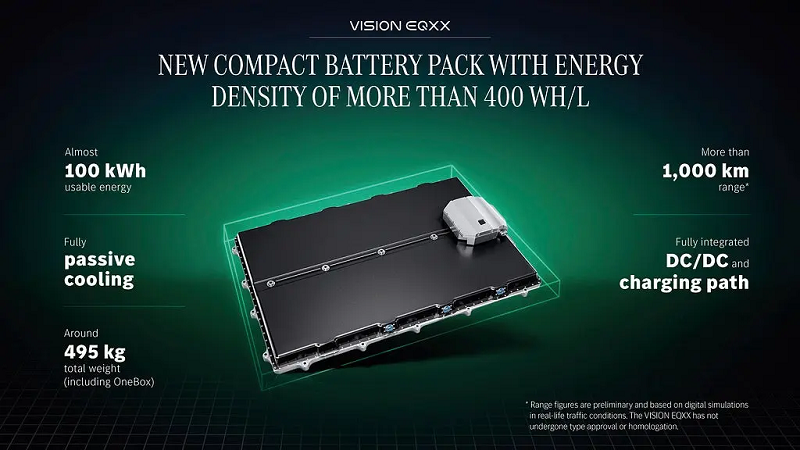On a single charge, a Mercedes-Benz AG electric car travelled over 1,000 kilometers (621 miles) from Germany to the French Riviera, pushing the battle to steal the technical spotlight from Tesla to a new level. At an average speed of just over 54 mph, this road legal idea was able to complete an 11-hour, 32-minute journey without stopping to charge its battery.
The EQXX prototype travelled from Sindelfingen, near Stuttgart, through Switzerland and Italy to Cassis, on the Mediterranean coast, according to the company. Because of the sedan's lightweight chassis and aerodynamic profile, it was able to finish the journey with a battery that was half the size of Mercedes' flagship electric vehicle, the EQS.
CEO Ola Kallenius said, “The EQXX is the most efficient Mercedes ever built. The technology program behind it marks a milestone in the development of electric vehicles.”
According to Mercedes, this milestone makes the EQXX the longest-range road-legal EV yet, though it's worth noting that while the EQXX is road-legal, you can't buy one, so it's not really a production car.
Even after that nearly 12-hour drive, the EQXX's 8.7 kWh per 62 miles of consumption average meant it could still have gone another 87 miles on the remaining energy in the battery. This outperforms the official range figures for the current winners in this category, the Tesla Model S (405 miles) and the Lucid Air (450 miles) (up to 520 miles per the EPA).
Battery Technology
It was also a demonstration of the EQXX's air-cooled rather than water-cooled high-silicon anode, high-energy density battery. Despite the fact that the battery pack only has a 100-kWh capacity, it is 50% lower in volume and 30% lighter than the 108-kWh pack on the Mercedes EQS. The battery is 78 x 50 x 4 inches in size and weighs just 1,091 pounds. The Vision EQXX uses permanent passive cooling with an underbody cooling plate to keep the battery cold. This results in a battery with a remarkable energy density of approximately 400 Wh/liter and an operating voltage of close to 900 volts.

The 180-kW Formula 1-derived powertrain, however, is not air-cooled. The drive motor's water cooling, on the other hand, allows Mercedes engineers to design an active, on-demand cooling system that can open and close shutters at radiator openings as needed to keep the system cool. Those shutters would also open when the air conditioning system's condenser needed to be cooled, ensuring that the interior stayed at a comfortable temperature while driving with minimal aerodynamic drag from the body apertures.
The temperature in the cabin is regulated by a heat pump that pulls air from the heat exchanger and the powertrain. A solar roof with 117 sun cells powers it and the full 12-volt system, reducing the draw on the driving battery. It also employs its regenerative system to recover lost energy when braking and coasting, and the entire drivetrain has been optimized to cut losses by 44 percent compared to a typical electric vehicle powertrain.
Lightweight Materials
The EQXX's incredible range is also attributable to the choice of lightweight components, such as aluminum brake discs, because the EQXX's energy recovery system is powerful enough to reduce the usage of hydraulic brakes. The rear floor also makes use of a new aluminum casting method, which allows for the use of a single part rather than many parts that would have added weight.
Furthermore, holes were constructed anywhere the structure didn't require additional strength, thus reducing weight. The battery's top is composed of a novel carbon-fiber-sugar combination, which requires a metal plate to assist passively cool it. The Vision EQXX weighs a sleek 3,869 pounds in total.
That weight is carried by a set of Bridgestone tires designed specifically for the Vision EQXX, which have a rolling resistance rating of just 4.7 for a 185/65R20 tire. This is much less than the rolling resistance of the EQS tires, which is 5.9. A revolutionary tire technology that lowers tire deformation when driving, as well as a tire belt that is tensioned higher than a regular tire, contribute to the low resistance. Bridgestone reduces not just the rolling resistance, but also the tire's weight by 20%.
Air Resistance
Air resistance is also a significant hindrance to high efficiency, which is why the EQXX has more than simply the shutters discussed previously. On the EQXX, the transition from the tire to the rim of the wheel was also tuned for aerodynamics. At maximum aerodynamic efficiency, the entire body was shaped for maximum aero efficiency and decreased drag, resulting in a CoD of 0.17. That's not terrible for a vehicle with a 22.82-square-foot frontal area.

While the Vision EQXX is a one-off, the technologies used in it will be carried over into Mercedes-next Benz's completely electric automobiles.









